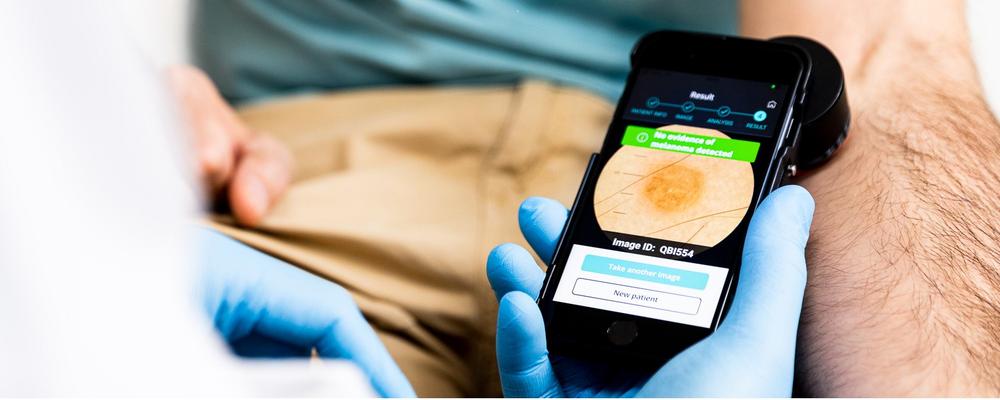
- Home
- News and events
- Find news
- AI-based app can help physicians find skin melanoma
AI-based app can help physicians find skin melanoma
A mobile app that uses artificial intelligence, AI, to analyse images of suspected skin lesions can diagnose melanoma with very high precision. This is demonstrated by a national study involving researchers from the University of Gothenburg. For the study, the app has been tested in clinical practice at primary care centers.
In recent years, AI has become as proficient as experienced dermatologists in analyzing dermoscopic images to identify melanoma. In some cases, the intelligent algorithms have even demonstrated higher precision compared to dermatologists’ assessments. However, only a few of the studies conducted have tested these systems under routine conditions.
Sam Polesie, Associate Professor at the Institute of Clinical Sciences at the University of Gothenburg, is one of the researchers behind the study.

“This is a remarkable study because it has been conducted in a real, clinical environment, making the results particularly convincing. I am enthusiastic about the results and look forward to being part of a future where a system like this, supported by rigorous research and in full compliance with all necessary regulations, is integrated into routine healthcare. This includes both general dermatology and specifically the diagnosis of skin cancer. The fundamental goal is, of course, to improve clinical decision-making processes to achieve more precise and therefore safer diagnoses,” says Sam Polesie.
A study in reality
“Our study is the first in the world to test an AI-based mobile app for melanoma in primary care in this way. A great many studies have been done on previously collected images of skin lesions and those studies relatively agree that AI is good at distinguishing dangerous from harmless ones. We were quite surprised by the fact that no one had done a study on primary care patients,” says Magnus Falk, senior associate professor at the Department of Health, Medicine and Caring Sciences at Linköping University, specialist in general practice at Region Östergötland, who led the current study.
Melanoma can be difficult to differentiate from other skin changes, even for experienced physicians. However, it is important to detect melanoma as early as possible, as it is a serious type of skin cancer.
“The app missed no melanomas”
There is currently no established AI-based support for assessing skin lesions in Swedish healthcare.

“Primary care physicians encounter many skin lesions every day and with limited resources need to make decisions about treatment in cases of suspected skin melanoma. This often results in an abundance of referrals to specialists or the removal of skin lesions, which in the majority of cases turn out to be harmless. We wanted to see if the AI support tool in the app could perform better than primary care physicians when it comes to identifying pigmented skin lesions as dangerous or not, in comparison with the final diagnosis,” says Panos Papachristou, researcher affiliated with Karolinska Institutet and specialist in general practice, main author of the study and co-founder of the company that developed the app.
And the results are promising.
“First of all, the app missed no melanoma. This disease is so dangerous that it’s essential not to miss it. But it’s almost equally important that the AI decision support tool could acquit many suspected skin lesions and determine that they were harmless,” says Magnus Falk.

Compared with healthcare diagnosis
In the study, primary care physicians followed the usual procedure for diagnosing suspected skin tumours. If the physicians suspected melanoma, they either referred the patient to a dermatologist for diagnosis, or the skin lesion was cut away for tissue analysis and diagnosis.
Only after the physician decided how to handle the suspected melanoma did they use the AI-based app. This involves the physician taking a picture of the skin lesion with a mobile phone equipped with an enlargement lens called a dermatoscope. The app analyses the image and provides guidance on whether or not the skin lesion appears to be melanoma.
To find out how well the AI-based app worked as a decision support tool, the researchers compared the app’s response to the diagnoses made by the regular diagnostic procedure.
“Further evaluation needed”
Of the more than 250 skin lesions examined, physicians found 11 melanomas and 10 precursors of cancer, known as in situ melanoma. The app found all the melanomas, and missed only one precursor. In cases where the app responded that a suspected lesion was not a melanoma, including in situ melanoma, there was a 99.5 percent probability that this was correct.
“It seems that this method could be useful. But in this study, physicians weren’t allowed to let their decision be influenced by the app’s response, so we don’t know what happens in practice if you use an AI-based decision support tool. So even if this is a very positive result, there is uncertainty and we need to continue to evaluate the usefulness of this tool with scientific studies,” says Magnus Falk.
The researchers now plan to proceed with a large follow-up primary care study in several countries, where use of the app as an active decision support tool will be compared to not using it at all.
The study was funded with support from Region Östergötland and the Analytic Imaging Diagnostics Arena, AIDA, in Linköping, which is funded by the strategic innovation programme Medtech4Health.
Text: Karin Söderlund Leifler (Linköping University)
and Elin Lindström (University of Gothenburg)